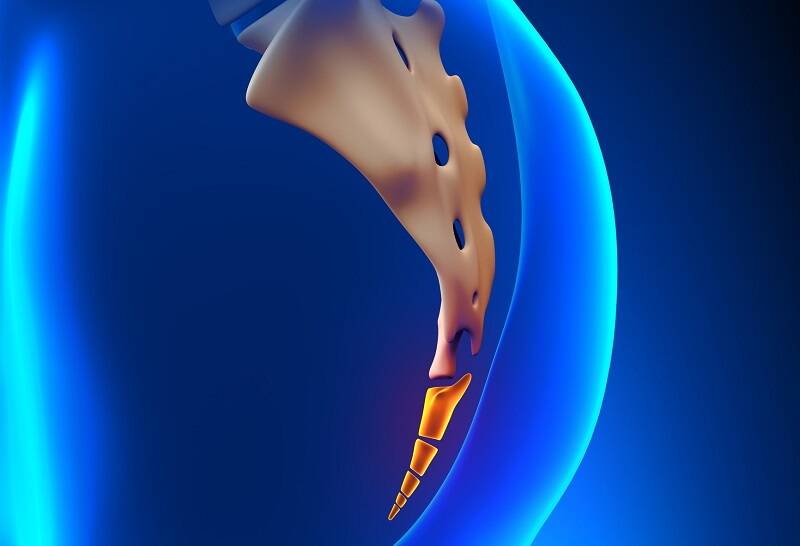- ncbi.nlm.nih.gov - expert article from the US National Libary of Medicine National Institutes of Health
- Patel, R; Appannagari, A; Whang, P.G. (May 2008). "Coccydynia". Current Reviews in Musculoskeletal Medicine. 1 (3–4): 223–226. doi:10.1007/s12178-008-9028-1. PMC 2682410. PMID 19468909.
- Patel, Ravi, Anoop Appannagari, and Peter G. Whang. "Abstract." National Center for Biotechnology Information. U.S. National Library of Medicine, 07 May 2008. Web. 21 May 2013.
- Postacchini F, Massobrio M (October 1983). "Idiopathic coccygodynia. Analysis of fifty-one operative cases and a radiographic study of the normal coccyx". J Bone Joint Surg Am. 65 (8): 1116–24.
- Kim NH, Suk KS (June 1999). "Clinical and radiological differences between traumatic and idiopathic coccygodynia". Yonsei Medical Journal. 40 (3): 215–20.
- Marx, Fred A. (1996). "Coccydynia/Levator Syndrome, A Therapeutic Test". Techniques in Coloproctology. 4 (1).
- Maigne JY, Doursounian L, Chatellier G (December 2000). "Causes and mechanisms of common coccydynia: role of body mass index and coccygeal trauma". Spine. 25 (23): 3072–9. doi:10.1097/00007632-200012010-00015. PMID 11145819. S2CID 25790826.
- Maigne, J., Doursounian, L., & Chatellier, G. (2000). Causes and mechanisms of common coccydynia: role of body mass index and coccygeal trauma. SPINE, 25(23), 3072-3079.
- Foye P, Buttaci C, Stitik T, Yonclas P (2006). "Successful injection for coccyx pain". Am J Phys Med Rehabil. 85 (9): 783–4.
- Ghormley RK (1958). "An Etiologic Study of Back Pain". Radiology. 70 (5): 649–653.
- Thiele, George H. (1963). "Coccygodynia: Cause and treatment". Diseases of the Colon & Rectum. 6 (6): 422–436.
- Maigne, JY; Tamalet, B (1996). "Standardized radiologic protocol for the study of common coccygodynia and characteristics of the lesions observed in the sitting position". Spine. 21 (22): 2588–93.
- Foye, P; Buttaci, C; Stitik, T; Yonclas, P (2006). "Successful injection for coccyx pain". Am J Phys Med Rehabil. 85 (9): 783–4.
- Onghena, Patrick; Van Houdenhove, Boudewijn (1992). "Antidepressant-induced analgesia in chronic non-malignant pain: a meta-analysis of 39 placebo-controlled studies". Pain. 49 (2): 205–219.
- Maigne, Jean-Yves, and Doursounian Levon. "Causes and Mechanisms of Common Coccydynia: Role of Body Mass Index and Coccygeal Trauma." Spine Journal 2.5.23 (2000): 3072-3079.
What causes coccygeal pain? Coccyx or coccygodynia syndrome - diseases

Photo source: Getty images
Most common symptoms
- Shoulder Blade Pain
- Malaise
- Feeling of heavy legs
- Chest pain
- Headache
- Joint Pain
- Limb pain
- Anal pain
- Nerve pain
- Leg Pain
- Painful bowel movements
- Flank Pain
- Lower Abdominal Pain
- Groin Pain
- Spirituality
- Pain that Radiates into the Shoulder
- Testicular pain
- Bone Pain
- Muscle stiffness
- Tingling
- Shooting pain in fingers and toes
- Back Pain
- Muscle weakness
- Pressure on the chest
Show more symptoms ᐯ
Treatment of coccygodynia: Medications, exercises, physiotherapy and rehabilitation
Show more









